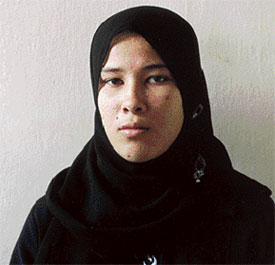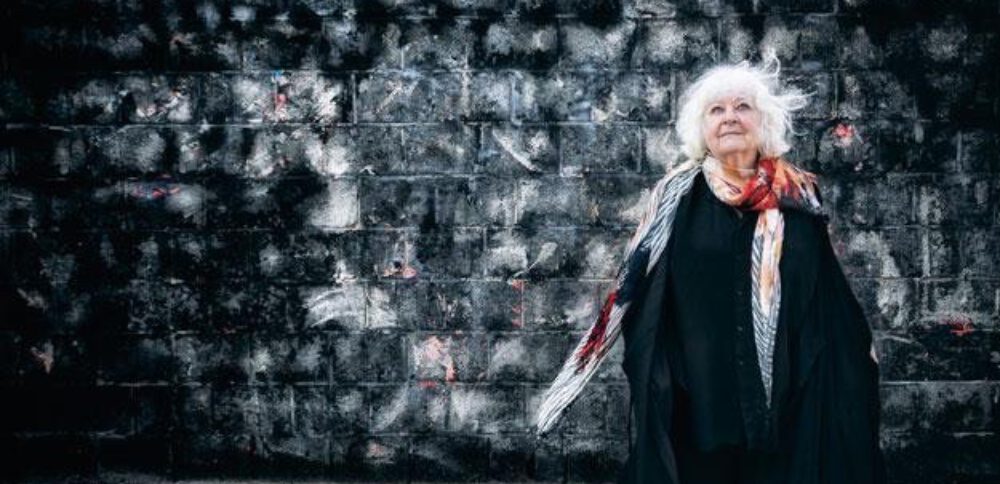
By Gideon Levy, Haaretz
This is Islam al-Atamna. A girl of 14. She is sitting in her black mourning clothes. Eight close relatives – including her mother, grandparents, uncles and aunts – were all killed before her eyes, one after the other. They were killed in the street after they awoke at home in horror at the sound of the first shell that exploded and then fled outdoors, where the next shells caught them.
About 11 fell on a residential neighborhood, one shell a minute, a rain of death, pursuing them in their flight. Fatherless for some time already, the girl is left alone in the world with her two little sisters and her 3-year-old brother Abdullah, whose legs were severed and who is hospitalized in the Al-Hilal Hospital in Gaza.
What should we say to Islam? What can we say to Islam? That the chip in the radar system is to blame? That the electronic component is responsible? Perhaps that the Palestinians are to blame?
Since the accident the girl has not fallen asleep for even a moment, which one can see in her frozen face. Islam is now a girl in shock, whose entire world was destroyed last Wednesday morning, with a total of 22 relatives dead and dozens wounded.
Advertisement
Islam’s town is upside down. The roads are full of open pits, crushed electricity poles, smashed cars, torn houses and a sewage system whose effluents flow quietly in the streets.
After the six-day war waged by the Israel Defense Forces against Beit Hanun during Operation Autumn Clouds – when soldiers also took over Islam’s house, imprisoning on the first floor the 104 people who lived in the eight apartments in the building, all relatives – people here expected to wake up last week to a new dawn, a dawn without soldiers. The day before, IDF had left Beit Hanun after “completing its mission” – nobody knows exactly what that mission was – and the residents awoke to freedom. But just then the volley of shells landed. Between 6:30 and 7 A.M., on the row of houses in the street that ends in a recently planted orchard, a gift from the Japanese government.
Now the survivors are sitting in the street of death, all of whose fatalities are members of one family, the Al-Atamna family. There has never before been such killing, of 22 members of one family, not even under direct Israeli occupation.
In the hospitals in Gaza, Egypt and Israel the wounded, about 40 in number, are moaning, many of them with amputated limbs and head injuries, quite a number of them children. The dead also include children, and mainly women: The mass poster that was printed presents the portraits of the men and the children who were killed, whereas the pictures of the women are replaced by paintings of red roses, as is the custom.
Flowers and children. A boy in a suit, a tie and glasses, Saad, 9 years old at his death; a boy in sunglasses, Mohammed, 11 years old; and a boy without glasses, Mahdi, 13. And there are the little ones: 3-year-old Maram and 8-month-old Maisa. All victims. Mothers and their children, grandfathers and their granddaughters, brothers and sisters, one after another, one shell after another. The IDF regrets …
The entrance to Beit Hanun is horrifying. It is a town that is half destroyed and half deserted. Some of the residents, those who had a place to go, fled while they were still able to do so and have yet to return. Those who remain are walking around the streets like victims of shell shock, trying to assess the damages. A few people with initiative have already begun reconstruction: One is building a new fence, another is clearing the ruins from his yard, and technicians are repairing electricity and telephone cables, until the next invasion. An old woman is drying loofa in her ruined yard, as though nothing has happened.
A disaster area. The roads have turned into sandy paths, the sewers bubble up in them, uprooted trees are scattered alongside and there are overturned carts with their contents spilling out. There is virtually no house whose fence was not hit. The ancient mosque, Um al-Nasser, which was destroyed except for its minaret and was the hiding place of the armed men, is surrounded by a row of houses that were almost totally destroyed. The clinic opposite the mosque was also damaged. “Kill, destroy, crush – you won’t succeed in breaking us,” is the message on a yellow fabric poster, in the name of the Fatah cell at the Al-Quds Open University.
The yard of the agriculture department is a mess, the playground of the high school for girls is torn up. “You are the members of the stronger nation,” thunders the voice of the dead leader Yasser Arafat from a loudspeaker mounted on a car that circulated in the town on the second anniversary of his death. In no other place did Arafat’s words sound as pathetic as they did this week in Beit Hanun. The same is true of the sight of the old woman who emerges from the ruins of her home, sits on the sand and makes a “V” with her fingers, a heartbreaking sign of an illusory victory.
The new cemetery: Here in the sands the people buried 16 of the victims of the shelling and inaugurated a new city of the dead for themselves. A row of graves decorated by palm branches, two gray bricks on each grave and the pictures of the dead scattered among them. One improvised sign was once a cardboard box from Angel’s bakery, regular white bread.
The pervasive atmosphere in the town is gloomy. The mourners’ tents are already empty, and the plastic chairs have been piled up, until the next time there is mourning. The mourners are only sitting now for Bassam Al-Atamna, Bassam who died late. He died of his wounds last Friday at Ichilov Hospital in Tel Aviv, after efforts to save him failed.
The mud-sewer road leads to the street of death. A short distance before the end of that street the apartment house is still standing, four stories, where most of the victims of the shelling lived. At least three shells hit this house, 16 of its tenants are no longer alive. But most of the residents were killed in the street, after managing to flee from the building.
On the fourth floor, in the apartment of the family of Amjad Al-Atamna, where two shells fell on two children’s rooms, tearing not-very-large holes in their ceilings, signs of the killing are still in evidence. The children were crushed here to pieces by the shells that landed on their heads while they were sleeping the peaceful sleep of little children. The Arabic notebook of Khalil Al-Atamna, wrapped in a cover with colorful cartoons, is among the ruins. Kahlil is hospitalized in serious condition. A third shell hit the wall of the stairwell, killing a mother and her two daughters while they were fleeing. The three were catapulted from the stairwell into the street.
The white IDF reconnaissance balloon looks down from the sky straight into the yards of the homes on this street. Did the balloon record the horror? Didn’t they see up there what the Artillery Corps was doing for about 15 minutes?
The IDF Spokesman told us this week that the army does not know how many of the 11 shells that were fired hit the houses and the street. The residents counted more than 10 shells that hit and can show the evidence: on ceilings and walls and in the craters that were created in the street.
Survivor Majdi Al-Atamna is most upset of all: He says that one of the soldiers beat him – despite the pacemaker in his heart – when they took over his house. He asked for an ambulance and recalls that the soldier replied: “Let him die. It doesn’t interest me.” A day after the soldiers and their dogs evacuated the house, he lost a son and two brothers, and another son is hospitalized in serious condition. “What did we do? They wanted to kill our family. Our entire family.”
Omar Al-Atamna woke up early Wednesday morning in order to listen to the news on the radio. The IDF had left a day earlier and he wanted to know what was new. Looking respectable in his suit, he talks about how he was drinking tea when he heard the sound of an explosion on the street. That was the first shell. Omar opened the window on the second floor and saw black smoke rising from one of the houses down the street. He quickly ran downstairs, but by the time he reached the first floor he already heard another explosion. The second shell. By the time he reached the street the next had already landed.
“I understood then that shells had hit my family,” he recalls. Horrified, he ran in the direction of the smoke that was now coming out of three houses, passed the home of his relatives, a couple who are the town’s dentists. It is important to Omar to explain that four doctors lived in the first house, in order to emphasize that they were “good families” – the kind that were not involved in anything. The doctors’ house was not hit, but the next one, that of his cousin Saad, a taxi driver, suffered a direct hit. Saad is now hospitalized in Egypt, with a serious neck injury. Four of the taxi driver’s children were wounded and are now amputees.
Omar removes from his jacket pocket a list written in pencil, with many erasures and scribblings. The list of dead and wounded. He reads the names of the former, one after another, like a shopping list: Abed Majdi, 9; Arafat Saad, 17; Mahdi Saad, 16; Mahmoud Saad, 15; Mahmoud Amjad, 9; Naama, 56 and her daughter Sanaa, 33; Massoud, 55; Manal, 29; Samir, 25; Fatma Massoud, 16; and Fatma Ahmed, 84, the grandmother of them all. Afterward he found another two names jotted down in the margins – Maram, 3, and Maisa, 8 months. But that was still not all of them.
Fourteen-year-old Islam recounts dryly: “We were sleeping in the house, on the third floor. We woke up to the noise of the first shell. The shell fell on the house of my Uncle Saad. We thought that they wanted to fire more shells and fled in the direction of the street. There another two shells fell on us; many were killed and many were wounded. We remained in the street. I saw my Grandma and my Mom collapsing in the street. When the ambulance came to evacuate my aunt, another two shells fell. Some of us were killed and some of us stayed alive. We saw how bodies were cut up before our eyes. Another ambulance came and more shells fell. The ambulance took my brother, whose two legs were cut off. He’s 3 years old. I saw Mom dead.”
Taxi driver Raad Al-Atamna, a member of the family and an old acquaintance of ours from the Erez checkpoint: “Her uncle was also killed, and another uncle is in a hospital in Egypt. Now she has nobody. What can I tell you, only God will look after her and help her. Gideon, I’m begging God not to harm either a Muslim or a Jew – no person should be harmed like us. It’s a tragedy, a Holocaust such as we have not had since 1956. I hope that what happened to us doesn’t happen to anyone else in the world.”

ik heb het gelezen.wat nu?